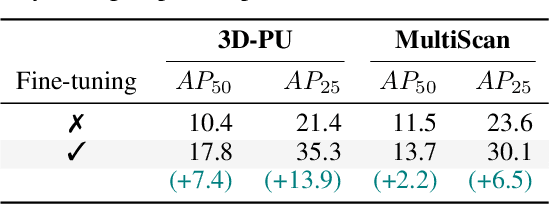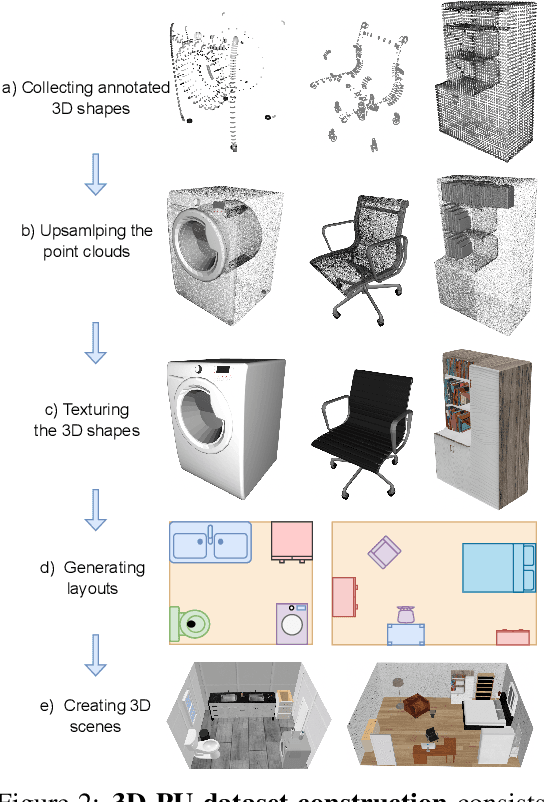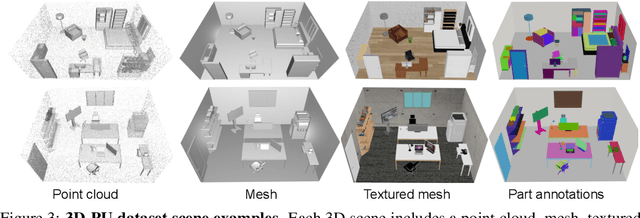Yuki M. Asano
3D sans 3D Scans: Scalable Pre-training from Video-Generated Point Clouds
Dec 28, 2025Abstract:Despite recent progress in 3D self-supervised learning, collecting large-scale 3D scene scans remains expensive and labor-intensive. In this work, we investigate whether 3D representations can be learned from unlabeled videos recorded without any real 3D sensors. We present Laplacian-Aware Multi-level 3D Clustering with Sinkhorn-Knopp (LAM3C), a self-supervised framework that learns from video-generated point clouds from unlabeled videos. We first introduce RoomTours, a video-generated point cloud dataset constructed by collecting room-walkthrough videos from the web (e.g., real-estate tours) and generating 49,219 scenes using an off-the-shelf feed-forward reconstruction model. We also propose a noise-regularized loss that stabilizes representation learning by enforcing local geometric smoothness and ensuring feature stability under noisy point clouds. Remarkably, without using any real 3D scans, LAM3C achieves higher performance than the previous self-supervised methods on indoor semantic and instance segmentation. These results suggest that unlabeled videos represent an abundant source of data for 3D self-supervised learning.
Test-Time Modification: Inverse Domain Transformation for Robust Perception
Dec 15, 2025Abstract:Generative foundation models contain broad visual knowledge and can produce diverse image variations, making them particularly promising for advancing domain generalization tasks. While they can be used for training data augmentation, synthesizing comprehensive target-domain variations remains slow, expensive, and incomplete. We propose an alternative: using diffusion models at test time to map target images back to the source distribution where the downstream model was trained. This approach requires only a source domain description, preserves the task model, and eliminates large-scale synthetic data generation. We demonstrate consistent improvements across segmentation, detection, and classification tasks under challenging environmental shifts in real-to-real domain generalization scenarios with unknown target distributions. Our analysis spans multiple generative and downstream models, including an ensemble variant for enhanced robustness. The method achieves substantial relative gains: 137% on BDD100K-Night, 68% on ImageNet-R, and 62% on DarkZurich.
Same Content, Different Answers: Cross-Modal Inconsistency in MLLMs
Dec 09, 2025Abstract:We introduce two new benchmarks REST and REST+(Render-Equivalence Stress Tests) to enable systematic evaluation of cross-modal inconsistency in multimodal large language models (MLLMs). MLLMs are trained to represent vision and language in the same embedding space, yet they cannot perform the same tasks in both modalities. Our benchmarks contain samples with the same semantic information in three modalities (image, text, mixed) and we show that state-of-the-art MLLMs cannot consistently reason over these different modalities. We evaluate 15 MLLMs and find that the degree of modality inconsistency varies substantially, even when accounting for problems with text recognition (OCR). Neither rendering text as image nor rendering an image as text solves the inconsistency. Even if OCR is correct, we find that visual characteristics (text colour and resolution, but not font) and the number of vision tokens have an impact on model performance. Finally, we find that our consistency score correlates with the modality gap between text and images, highlighting a mechanistic interpretation of cross-modal inconsistent MLLMs.
Franca: Nested Matryoshka Clustering for Scalable Visual Representation Learning
Jul 18, 2025Abstract:We present Franca (pronounced Fran-ka): free one; the first fully open-source (data, code, weights) vision foundation model that matches and in many cases surpasses the performance of state-of-the-art proprietary models, e.g., DINOv2, CLIP, SigLIPv2, etc. Our approach is grounded in a transparent training pipeline inspired by Web-SSL and uses publicly available data: ImageNet-21K and a subset of ReLAION-2B. Beyond model release, we tackle critical limitations in SSL clustering methods. While modern models rely on assigning image features to large codebooks via clustering algorithms like Sinkhorn-Knopp, they fail to account for the inherent ambiguity in clustering semantics. To address this, we introduce a parameter-efficient, multi-head clustering projector based on nested Matryoshka representations. This design progressively refines features into increasingly fine-grained clusters without increasing the model size, enabling both performance and memory efficiency. Additionally, we propose a novel positional disentanglement strategy that explicitly removes positional biases from dense representations, thereby improving the encoding of semantic content. This leads to consistent gains on several downstream benchmarks, demonstrating the utility of cleaner feature spaces. Our contributions establish a new standard for transparent, high-performance vision models and open a path toward more reproducible and generalizable foundation models for the broader AI community. The code and model checkpoints are available at https://github.com/valeoai/Franca.
Segment Any 3D-Part in a Scene from a Sentence
Jun 24, 2025



Abstract:This paper aims to achieve the segmentation of any 3D part in a scene based on natural language descriptions, extending beyond traditional object-level 3D scene understanding and addressing both data and methodological challenges. Due to the expensive acquisition and annotation burden, existing datasets and methods are predominantly limited to object-level comprehension. To overcome the limitations of data and annotation availability, we introduce the 3D-PU dataset, the first large-scale 3D dataset with dense part annotations, created through an innovative and cost-effective method for constructing synthetic 3D scenes with fine-grained part-level annotations, paving the way for advanced 3D-part scene understanding. On the methodological side, we propose OpenPart3D, a 3D-input-only framework to effectively tackle the challenges of part-level segmentation. Extensive experiments demonstrate the superiority of our approach in open-vocabulary 3D scene understanding tasks at the part level, with strong generalization capabilities across various 3D scene datasets.
Self-supervised Learning of Echocardiographic Video Representations via Online Cluster Distillation
Jun 13, 2025Abstract:Self-supervised learning (SSL) has achieved major advances in natural images and video understanding, but challenges remain in domains like echocardiography (heart ultrasound) due to subtle anatomical structures, complex temporal dynamics, and the current lack of domain-specific pre-trained models. Existing SSL approaches such as contrastive, masked modeling, and clustering-based methods struggle with high intersample similarity, sensitivity to low PSNR inputs common in ultrasound, or aggressive augmentations that distort clinically relevant features. We present DISCOVR (Distilled Image Supervision for Cross Modal Video Representation), a self-supervised dual branch framework for cardiac ultrasound video representation learning. DISCOVR combines a clustering-based video encoder that models temporal dynamics with an online image encoder that extracts fine-grained spatial semantics. These branches are connected through a semantic cluster distillation loss that transfers anatomical knowledge from the evolving image encoder to the video encoder, enabling temporally coherent representations enriched with fine-grained semantic understanding. Evaluated on six echocardiography datasets spanning fetal, pediatric, and adult populations, DISCOVR outperforms both specialized video anomaly detection methods and state-of-the-art video-SSL baselines in zero-shot and linear probing setups, and achieves superior segmentation transfer.
SAMSelect: A Spectral Index Search for Marine Debris Visualization using Segment Anything
Jun 10, 2025Abstract:This work proposes SAMSelect, an algorithm to obtain a salient three-channel visualization for multispectral images. We develop SAMSelect and show its use for marine scientists visually interpreting floating marine debris in Sentinel-2 imagery. These debris are notoriously difficult to visualize due to their compositional heterogeneity in medium-resolution imagery. Out of these difficulties, a visual interpretation of imagery showing marine debris remains a common practice by domain experts, who select bands and spectral indices on a case-by-case basis informed by common practices and heuristics. SAMSelect selects the band or index combination that achieves the best classification accuracy on a small annotated dataset through the Segment Anything Model. Its central assumption is that the three-channel visualization achieves the most accurate segmentation results also provide good visual information for photo-interpretation. We evaluate SAMSelect in three Sentinel-2 scenes containing generic marine debris in Accra, Ghana, and Durban, South Africa, and deployed plastic targets from the Plastic Litter Project. This reveals the potential of new previously unused band combinations (e.g., a normalized difference index of B8, B2), which demonstrate improved performance compared to literature-based indices. We describe the algorithm in this paper and provide an open-source code repository that will be helpful for domain scientists doing visual photo interpretation, especially in the marine field.
CROC: Evaluating and Training T2I Metrics with Pseudo- and Human-Labeled Contrastive Robustness Checks
May 16, 2025Abstract:The assessment of evaluation metrics (meta-evaluation) is crucial for determining the suitability of existing metrics in text-to-image (T2I) generation tasks. Human-based meta-evaluation is costly and time-intensive, and automated alternatives are scarce. We address this gap and propose CROC: a scalable framework for automated Contrastive Robustness Checks that systematically probes and quantifies metric robustness by synthesizing contrastive test cases across a comprehensive taxonomy of image properties. With CROC, we generate a pseudo-labeled dataset (CROC$^{syn}$) of over one million contrastive prompt-image pairs to enable a fine-grained comparison of evaluation metrics. We also use the dataset to train CROCScore, a new metric that achieves state-of-the-art performance among open-source methods, demonstrating an additional key application of our framework. To complement this dataset, we introduce a human-supervised benchmark (CROC$^{hum}$) targeting especially challenging categories. Our results highlight robustness issues in existing metrics: for example, many fail on prompts involving negation, and all tested open-source metrics fail on at least 25% of cases involving correct identification of body parts.
Self-supervised Normality Learning and Divergence Vector-guided Model Merging for Zero-shot Congenital Heart Disease Detection in Fetal Ultrasound Videos
Mar 10, 2025Abstract:Congenital Heart Disease (CHD) is one of the leading causes of fetal mortality, yet the scarcity of labeled CHD data and strict privacy regulations surrounding fetal ultrasound (US) imaging present significant challenges for the development of deep learning-based models for CHD detection. Centralised collection of large real-world datasets for rare conditions, such as CHD, from large populations requires significant co-ordination and resource. In addition, data governance rules increasingly prevent data sharing between sites. To address these challenges, we introduce, for the first time, a novel privacy-preserving, zero-shot CHD detection framework that formulates CHD detection as a normality modeling problem integrated with model merging. In our framework dubbed Sparse Tube Ultrasound Distillation (STUD), each hospital site first trains a sparse video tube-based self-supervised video anomaly detection (VAD) model on normal fetal heart US clips with self-distillation loss. This enables site-specific models to independently learn the distribution of healthy cases. To aggregate knowledge across the decentralized models while maintaining privacy, we propose a Divergence Vector-Guided Model Merging approach, DivMerge, that combines site-specific models into a single VAD model without data exchange. Our approach preserves domain-agnostic rich spatio-temporal representations, ensuring generalization to unseen CHD cases. We evaluated our approach on real-world fetal US data collected from 5 hospital sites. Our merged model outperformed site-specific models by 23.77% and 30.13% in accuracy and F1-score respectively on external test sets.
Unsupervised Parameter Efficient Source-free Post-pretraining
Feb 28, 2025Abstract:Following the success in NLP, the best vision models are now in the billion parameter ranges. Adapting these large models to a target distribution has become computationally and economically prohibitive. Addressing this challenge, we introduce UpStep, an Unsupervised Parameter-efficient Source-free post-pretraining approach, designed to efficiently adapt a base model from a source domain to a target domain: i) we design a self-supervised training scheme to adapt a pretrained model on an unlabeled target domain in a setting where source domain data is unavailable. Such source-free setting comes with the risk of catastrophic forgetting, hence, ii) we propose center vector regularization (CVR), a set of auxiliary operations that minimize catastrophic forgetting and additionally reduces the computational cost by skipping backpropagation in 50\% of the training iterations. Finally iii) we perform this adaptation process in a parameter-efficient way by adapting the pretrained model through low-rank adaptation methods, resulting in a fraction of parameters to optimize. We utilize various general backbone architectures, both supervised and unsupervised, trained on Imagenet as our base model and adapt them to a diverse set of eight target domains demonstrating the adaptability and generalizability of our proposed approach.
 Add to Chrome
Add to Chrome Add to Firefox
Add to Firefox Add to Edge
Add to Edge